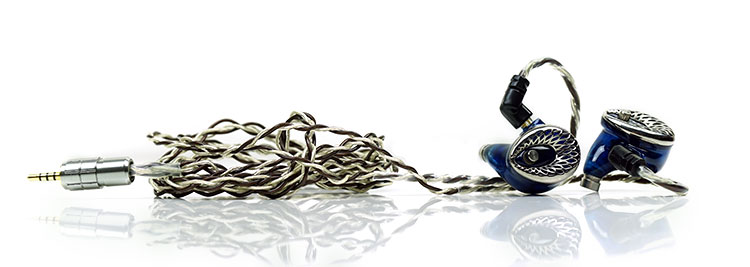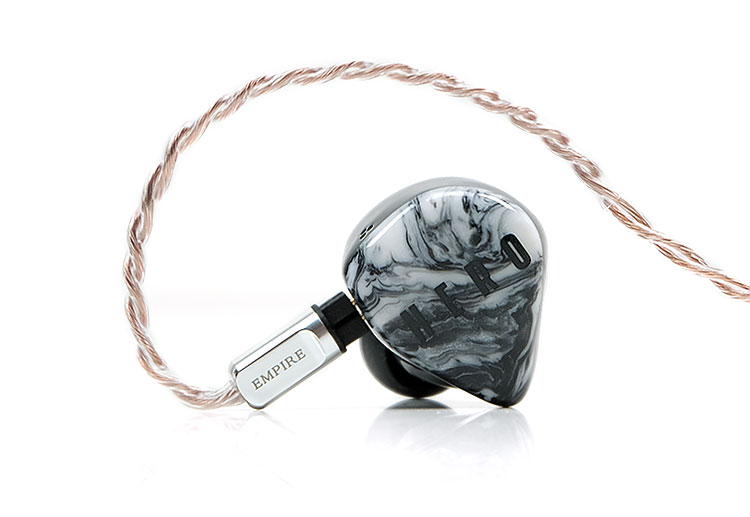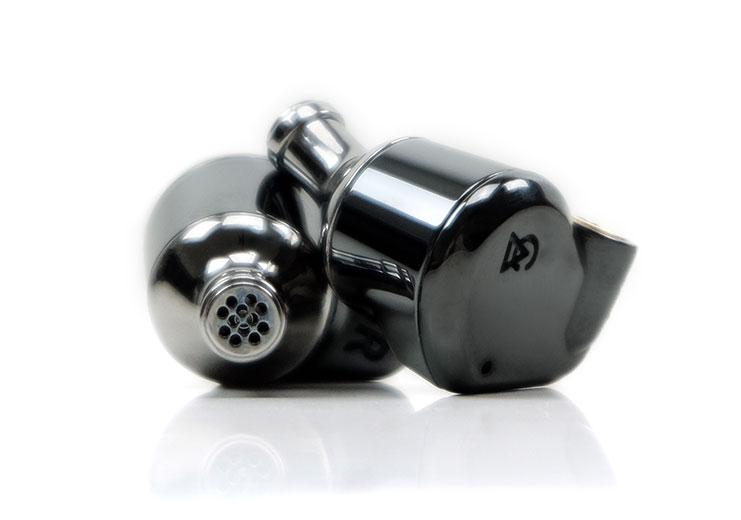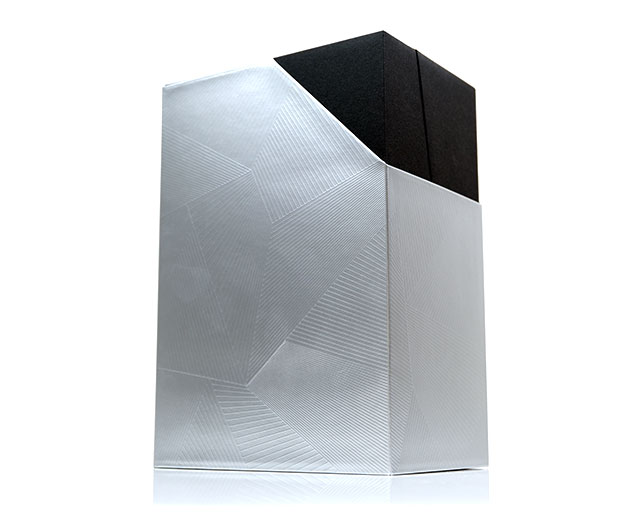Sound Impressions
Summary
Thank you qdc for restoring my faith in multiple dynamic driver configurations. I honestly was not expecting much after the 3DD-Ti but this seems a very balanced and enjoyable tuning and not what I was expecting at all.
The focus here is on listenability. What I mean by that is a gentle lift in key areas to emphasize PRaT, vocal likeability, and generally a smooth but articulate treble performance.
The Dmagic 3D has that trademark dynamic driver timbre throughout with a mildly bumped but solid-sounding low-end, a fairly focused midrange bump around 1-3k for vocal presence, and a milder upper-mids rise around 4-5k.
Tips are important here. With the single-bore silicone tips, the lower treble is second fiddle to the upper treble with more of a rise around 8-10k producing a slightly ethereal tone to higher pitching timbre. You also get a bit of shimmer with a glassy tone to percussion and vocals which I didn’t find that appealing.
Switching to double flange softens the attack, adds a bit more body, and produces a nice extended upper treble sparkle without those nasty sharp partial overtones to go with it. This is when the Dmagic 3D starts to sound neigh on perfect for my personal preferences.
There does not seem to be a huge lower-mids scoop in the Dmagic 3D tuning. It does dip a shade into the lower-mids to prevent it from sounding muddy and bloated, but the low-end is not hugely emphasized, so the cut from the elevated mid-bass presence is not that extreme.
That allows midrange instrumental notes to take on some pleasing warmth and presence. That bodes well for rock and metal lovers as well as offering enough density and punch for EDM fans.
Timbre
The Dmagic 3D timbre is addictive, really just a perfect balance between sweet and natural in terms of its harmonic balance.
There seems to be something in the way qdc tunes a lot of their monitors that seems tailor-made for my own listening preferences. Of course, that does not necessarily mean you the reader will like what I like but it does make it easier for me to explain.
With the dual flange tips, the timbre veers to the natural to slightly euphonic side with a nicely weighted mid-bass punch, plenty of dynamic driver texture, and a bit of sweetness in its forward voicing.
The treble has enough presence to keep percussion lively and clean without stripping out the body and retains a relatively liquid feel to its attack.
Those looking for absolute sub-bass power might not get it with the Dmagic 3D. Not that it lacks extension, the dynamic driver low-end is excellent in terms of depth, but rather its weighting is unlike the Hero from Empire Ears or the Campfire Audio Dorado 2020 in terms of a pure sub-bass bias.
That means more mid-bass punch, less of a lower-mids dip, and consequently better instrumental body and presence. Particularly rock guitar chord riffs or that classic Les Paul sound which sounds almost perfect in terms of weight and texture.
It does make old rock classics from the 80s swing with authority with delicious meaty plucks, a natural level of decay, and great control on unwanted upper-bass bloom.
Staging
Staging on the Dmagic 3D is ok on depth, slightly more on the intimate side for mids vocal presence, and reasonably tall with very good headroom.
That 2-3k peak might steal some of your attention but it depends entirely on what is pitching there. If it’s a solo female vocal performance it is delightful, percussion passages possibly less so.
If you are coming from something like the 3DD-Ti you will pick up very quickly how much more engaging the Dmagic 3D dynamic range is. The degree of instrumental separation is so much better which helps a lot with quick-paced nuanced spatial cues or fast stage ‘pan and scan’ mixing.
The drivers actually seem quite fast for dynamic though not quite as pacey sounding as BA drivers. That being said the articulation and imaging are very natural sounding within the space afforded.
The resulting soundstage sounds ‘close’ but impeccably controlled with vocals and mid-bass punch to the fore and instruments just marginally tucked in behind to give some depth to performances.
In a way, the Dmagic 3D is a bit of an antidote to a rash of bombastic V-shaped high-end monitors I have been reviewing recently and feels almost like a perfect compliment with its solid midrange presence and intimate but natural vocal performances.
Synergy
Efficiency
The qdc Dmagic 3D is rated at 13.5Ω and 98dB SPL so not too much impedance but the use of dynamic drivers will negate the concerns about impedance skew from high impedance outputs. I have never found dynamic drivers to suffer from that compared to BA drivers.
The 98dB SPL does mean you will need a bit more juice or volume from your source or amp compared to hyper-sensitive alternatives.
I would say the efficiency level is also lower than a few dynamic driver-infused hybrids such as the recently reviewed Empire Ears Hero and the Campfire Audio Dorado 2020. Perhaps due to driving 3 dynamic drivers as opposed to just one?
That does not mean you need plenty of power though. I found DAPs such as the Lotoo PAW Touch Gold with up to 0.5W output to pair just fine with the Dmagic 3D in low-gain mode, as well as the M15 from FiiO and the HiBy R8.
You just need to push the volume level up a little more than you would for the previously mentioned hybrids and a lot more than an Andromeda 2020.
Pairings
Honestly, the Dmagic 3D is an incredibly flexible sound signature and does not need a massive amount of power to sound right. The pairings are going to come down to tonal preferences and how much separation, treble coloration, or natural timbre you would want in your presentation.
Natural
I tested 4 DAPs with the Dmagic 3D including the Cayin N6oo/E02 pairing, the Lotoo PAW Gold Touch, HiBy R8, and the FiiO M15.
You can safely divide them 2 x 2 with the Lotoo and FiiO offering something more neutral and articulate than the other two which tended to offer something a little sweeter in the case of the Cayin or warmer for the R8.
The R8 probably rolled off the top end the most out of the 4 DAPs with the Dmagic 3D pairing. It did sound the most euphonic of the 4 DAPs in terms of synergy and also the richest in terms of bass quantity.
The E02 lightened up the warmth just marginally enough to sound the sweeter of these two DAPs with a slightly cleaner treble response.
Neutral
On the opposing side, the M15 did a nice job with bass definition and layering. It kind of made the R8 pairing a little soft-sounding in comparison with very tight and precise control of the bass. However, the Dmagic 3D treble did sound harder, and the mid-timbre was a bit brighter as a result.
The Lotoo PAW Gold Touch also tightened things up from the two warmer DAPs with some killer separation but did not inject as much brightness as the M15 delivering probably the most balanced and reference sound of the 4.
None of them gave me any problems with hiss offering a nice black background when paired with the Dmagic 3D and all 4 sound optimal with the balanced 4.4mm interchangeable jack. The E02 pairing on the N6ii only comes with a balanced output so brownie points there for qdc.
Select Comparisons
Unique Melody 3DD-Ti
$1099
Technical
Despite its age, the 3DD-Ti from Unique Melody is just about the only direct triple dynamic driver comparison to the Magic 3D that I can think of, even as we roll into 2021.
The configuration is a little different though both use a 3-way crossover network logically enough. In terms of driver sizes the UM uses a larger 13mm dynamic driver for the low-end, an 8mm for the mids, and a smaller micro-DD 6mm for the highs.
The Dmagic 3D design is a little more complex. The lows and mids are covered by the coaxial dual dynamic driver 10mm driver for both the lows and mids and a single but larger 8mm compound vibrating diaphragm for the highs.
Beyond the internal configuration, the 3DD-Ti also can fine-tune the amount of bass from the 13mm driver by up to 4dB from a dB-Go dial module on the front faceplate.
The 3DD-Ti is rated at 20.5Ω with a medium efficiency of 98dB SPL. The Dmagic 3D is very close to this marker on paper at 13.5Ω and has the same 98dB SPL rating. Both do need a little bit of current to sound optimal and neither I would class as sensitive IEMs.
In our real-world testing, there was a bit of a difference in volume matching between these two monitors so the specs do not tell the full story.
Overall, the Dmagic 3D sounded louder and livelier than the 3DD-Ti at a similar low-gain volume setting of 70 on the Lotoo PAW Gold Touch. Neither have any background hiss issues with the likes of the HiBy R8 and FiiO M15 balanced output.
Design
Quite a different design approach from the two companies and hand on heart I have to say I much prefer the qdc wood stabilizing resin nebula design.
The UM design is more niche for me with that tall oval lattice-type titanium faceplate and blue 3D-printed acrylic shell underneath. It is interesting and unique but not as flash and interesting as the Dmagic 3D aesthetic. Perhaps the time has been unkind since UM has come a long way since this design came out.
The form factor on the 3DD-Ti is a little taller and slightly narrower with that oval faceplate on top. The nozzle is a lot longer on the 3DD-Ti which I like. The shorter Dmagic 3D nozzle is compensated however with the use of tall dual flange tips but you will still feel the 3DD-Ti go a bit deeper.
Because of the deeper insertion depth, the 3DD-Ti does isolate marginally better than the Dmagic 3D, even with the dual flange tips making up for some of that insertion depth.
The 3DD-Ti uses a 4-core 1.3m OFC wire in a two-tone transparent PVC jacket and some sturdy aluminum jack barrels. The Dmagic 3D has a slightly better 26AWG copper and silver inside an 8-core parallel wire with that excellent interchangeable jack head system.
The only caveat is qdc’s use of reversed polarity connectors which make it tricky to roll the cables without adapters.
Performance
One of those rare moments where I can come right out with the statement that one is simply better than the other. The Dmagic 3D stomps all over the 3DD-Ti both on a technical and tuning level.
The first thing is the lack of comparative dynamic range on the 3DD-Ti, like the drivers are placed too far to the rear and the chamber combined with the long nozzle is compressing the sound. It is not veiled but it lacks sparkle and openness like it’s hitting too much of an acoustical wall leaving it sounding relatively compressed.
In contrast, the Dmagic 3D sounds far more engaging, with better separation, and more clarity. The balance and cohesion between the 3 drivers are far superior. Also, the mids 1-3k hump is a little broader and more substantial than the 3DD Ti meaning vocal imaging sounds clear, smooth, and forward.
The 3DD-Ti has a very narrow band high peak around 2-3k and a minor bump from 1-2k, it is tonally quite uneven. The resulting sound can often deliver a vocal performance that lacks comparative engagement or if it hits that narrow peak comes through as a little sibilant.
Treble is also more evenly tuned on the Dmagic 3D with a natural but slow fade that gives it a smooth but clean performance. The 3DD Ti is much more uneven with dips on either side of a narrow band 7k peak.
That results in a lack of upper mids air and upper treble headroom. That peak just colors the mids timbre enough to prevent it from being veiled sounding.
The low-end is more dominant on the 3DD-Ti with more sub-bass presence if you use the db-GO module but it feels disconnected and uneven with a fair old dip into the lower-mids.
The Dmagic 3D bass is more evenly spread with a minor sub-bass roll-off and good mid-bass weight and warmth with better lower-mids presence.
Empire Ears Hero
$1399
Technical
We just recently reviewed the Hero back in December 2020 and gave it a healthy score with its dynamic performance. The price point is also quite similar to the Dmagic 3D.
Internally, both are multi-driver but the Hero is a hybrid or mix of BA and dynamic whereas the Dmagic 3D is all dynamic. The Hero uses a single but very potent W9+ 9mm dynamic subwoofer for the lows and 3 proprietary balanced armature drivers with one for the mids, 1 for the mid-highs, and 1 for the highs.
The Dmagic 3D uses a coaxial dual dynamic driver 10mm driver for both the lows and mids and a single but larger 8mm compound vibrating diaphragm for the highs. Both have crossover tech but it is 4-way for the Hero and 3-way for the Dmagic 3D.
The rating is a little different with the Hero spec’ed at 17.5Ω and 105dB SPL and what I would term as medium efficiency. The Dmagic 3D is a little harder to drive due to its 98dB SPL though impedance is lower at 13.5Ω.
In our real-world testing, the Hero volume matches a good 10 steps lower than the Dmagic 3D on the Lotoo PAW Gold Touch in low gain. The Dmagic 3D does require a bit more current as the specs would suggest whereas the Hero will happily play off weaker sources and still sound optimal.
In terms of noise that does mean also the Dmagic 3D will be more resistant to hiss on higher-powered outputs. For example, the HiBy R8 in balanced mode did give a tiny bit of waterfall hiss whereas the Dmagic 3D had a perfectly black background.
Design
The designs are quite different but the form factors are closely aligned with their acrylic bodies. I would say maybe the Dmagic 3D’s acrylic shell contouring is a bit more aggressive so it sits flusher in the ear and the overall dimensions are a bit smaller compared to the Hero.
The Hero has a longer snout and sits a little deeper than the Dmagic 3D but there is not much of a difference in their isolation levels with both requiring bass venting ports and therefore not on the same level as a pure BA design. Still, the fit and comfort of both are excellent and the isolation is above average for vented builds.
The aesthetics again are all qdc. I admire the Black Tide faceplate on the Hero with its Noire vibe but behind the all-black shell is a slightly missed opportunity. qdc goes 100% with that wood resin nebula design and looks all the better for it. More complete shall we say and more integrated.
Both have good cables. The Hero uses the Alpha IV which is a 26AWG 4-wire multi-size UPOCC Litz copper strand geometry. It is terminated with an aluminum and carbon fiber printed jack barrel, a complimentary lightweight aluminum chrome splitter, and their new overmolded 0.78mm 2-pin connectors.
The Dmagic 3D uses 26AWG copper and silver inside an 8-core parallel wire geometry. I think the Alpha IV Litz wire is better quality but with that excellent interchangeable jack head system, the Dmagic 3D cable is more flexible.
Performance
The Hero is much more of a classic V-shape in its tuning compared to the lightly U-shaped Dmagic 3D. The sound is an ‘explosive’ high-contrast sound with more top and bottom emphasis whereas the Dmagic 3D has a bit more balance and warmth and a stronger lower-mids presence.
The Hero has a deeper sub-bass extension and more power compared to the Dmagic 3D which is tuned for a longer sustain and elevation through the mid-bass.
As a result, the Dmagic 3D sounds a little warmer and richer though the bass and lower-mids but not quite the same amount of rumble and depth.
The Dmagic 3D low-end dynamic driver also seems a little slower than the Hero Weapon IX+ for me, but that could also be the overall effect of the 3 dynamic drivers since the Hero uses nippier balanced armatures for the mids and highs.
You can hear the textural difference between the two driver configurations beyond the lows.
Timbre
Beyond that, the timbre on the Hero is much cooler and cleaner with a steep midbass dip into the lower-mids whereas the Dmagic 3D has less of a dip and more body through the lower-mids.
The vocals on both are good but again a different timbre with the Hero offering a sweet almost ethereal tone to upper-mid vocals and a clean but dipped lower-mid vocal presence.
The Dmagic 3D does better with vocal balance and solidity with a more liquid sound, and richer texture but also more intimate and engaging. The Hero is built for high impact but the textural weight is much lighter from those BA drivers.
The treble is a little softer and more liquid on the Dmagic 3D though by no means rolled off. Rather the Hero is more forward-sounding, with enhanced sparkle and extension. It has a classic fast BA articulation but also BA timbre so it can sound brighter and drier for higher register instrumental timbre.
I think these two monitors complement each other perfectly but the Dmagic has a bit more flexibility across a wider range of genres. The Hero will excite, and sounds awesome for EDM, but will come up a bit short for a lot of mid-tempo rock and soulful vocal tracks.
Campfire Audio Dorado 2020
$1099
Technical
The last review of 2020, the aptly named Dorado 2020, and priced a shade lower than the Dmagic 3D.
This, like the Hero and the Dmagic 3D, is a multi-driver design but like the Hero, it is a hybrid with a single A.D.L.C. 10mm dynamic driver for the lows and mids and a single BA in the nozzle for the highs. There is no crossover tech inside the Dorado 2020.
The Dmagic 3D seems a little more complex with a 3-way crossover and that coaxial dual 10mm driver for the mids and lows and a single 8mm dynamic driver for the highs.
The SPL rating is a bit hard to compare on paper as Campfire and qdc use different measuring systems but the impedance is not far apart at 10Ω for the Dorado 2020 and 13.5Ω for the Dmagic 3D.
In our real-world testing, I found the Dorado 2020 to be the more sensitive of the two by around 5 steps in low gain on the Lotoo PAW Gold Touch so my guess is around 105dB SPL on the old measurement system compared to the 98dB SPL of the Dmagic 3D.
Neither has an issue with background hiss on DAPs as neither are hugely sensitive to it. Both ran pretty quietly out of the FiiO M15 and the HiBy R8 with very low noise floors.
Design
Very different design approaches with the qdc Dmagic 3D a little bit bigger but also lighter due to the use of acrylics save for the stainless-steel nozzle.
The Dorado 2020 uses a dense ceramic enclosure with a machined brass spout finished in PVD and all over has this shiny gunmetal finish. It’s the more durable of the two, the heavier but smaller of the two also.
The Dmagic 3D acrylic means it is also aggressively contoured to fit comfortably in your ear with the tips finishing the seal with that short nozzle.
The Dorado 2020’s lack of contouring which is more difficult with ceramics does very well in terms of fitting. The smaller form factor means it does not need to curve around so much for the ear and instead the tips do most of the seal and secure work.
Both isolate about the same which is fair considering both are venting dynamic drivers though the comfort level may be just the edge for the Dorado 2020 with the stock Final E tips which I love.
The Dorado 2020 is MMCX terminated which is fairly commonplace compared to the reversed polarity 2-pin of the Dmagic 3D.
The 2 stock cables are good with the Dorado using a lightweight and low-noise 4-core 1.2m SPC Litz in a smoky black jacket and the Dmagic 3D using a bulkier but equally low noise 26AWG copper and silver inside an 8-core parallel wire, (4×4), geometry.
Once again, that interchangeable jack system on the qdc could be the difference-maker for those needing maximum cable flexibility.
Performance
The Dorado 2020 is also an out-and-out V-shaped tuning though with not quite the same emphasis as the Hero. It has plenty of sub-bass power compared to the Dmagic 3D but dips harder into the lower-mids leaving a lot less presence but much more separation.
The Dmagic 3D has a smoother transition into the lower-mids but less sub-bass power and elevation. You get a punchier mid-bass and better lower-mids body on the Dmagic 3D as a result but slightly less overall power.
Mids, like the Hero, have a very clean tone, light in body with a vocal that ranges from dipped to ethereal and slightly more forward depending on where they pitch.
The Dmagic 3D again is more consistent with a better body and a richer timbre throughout the mids. It does sound the more intimate of the two also with that pronounced 1-3k bump that is not so pushed on the Dorado 2020.
Treble is brighter and more articulate on the Dorado 2020 and more forward sounding. It is also leaner in tone and drier with a distinct BA texture shining through.
The Dmagic 3D is not quite as extended, with a gradual fade up into the upper treble but still plenty of headroom. It does soften the treble nicely and sucks out a lot of potential hard contrasting tones that the Dorado 2020 needs to balance that V-shaped tuning out.
Overall, it is much the same conclusion as the Hero. The Dmagic 3D is more flexible, probably less fatiguing but not as deep or as tall sounding, more intimate overall, and better for vocals. The Dorado 2020 is more niche, stronger for EDM, and music heavy on arena-like atmospherics.
Our Verdict
The qdc Dmagic 3D is a great start to 2021 and I guess a benchmark for future incoming monitors to be measured against. It exactly mirrors my personal listening preferences which is a phenomenon quite common with qdc reviews for me over the last few years.
For those wondering if it will match yours, the Dmagic 3D is coherent sounding, natural to slightly euphonic, and very suitable for a wide range of genres, particularly rock standards, and vocal performances.
It is not super sensitive so not a hiss detector and will blend very nicely indeed with plenty of resolving sources.
And yes, the aesthetics are beautiful as always. Some very clever people in qdc know how to make a beautiful-looking and compelling-sounding monitor right now.
qdc Dmagic 3D Specifications
- Sensitivity: 98dB SPL/mW
- Frequency response: 10Hz-30000Hz
- Impedance: 13.5Ω
- Driver units: 3 Dynamic Drivers
- Noise isolation: 26dB
- Monitor plug: 3 in 1 push type replaceable plug
- Technical feature: Dmagic patented technology, 3 crossovers, 3 dynamic drivers, 2 way sound channels






